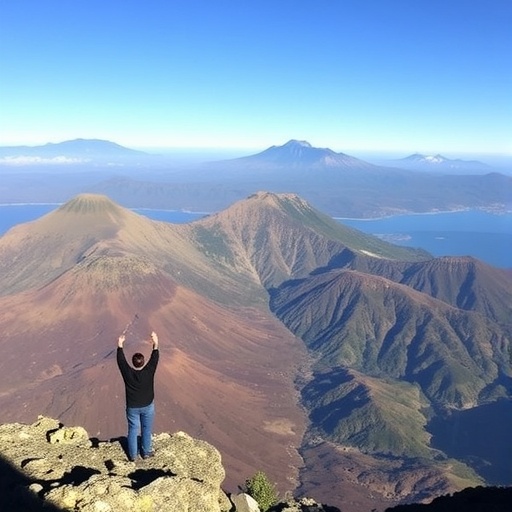The Campi Flegrei caldera in Italy, renowned for its geological activity, has captured the attention of scientists and the public alike due to its recent unrest. In a significant study led by Giordano et al., researchers delve into the birth and development of a volcanotectonic fault within this volcanic region, presenting their findings in the journal “Commun Earth Environ.” With an emphasis on the geophysical implications and the underlying processes driving the current unrest, this research offers insights into the complex interactions that characterize the Campi Flegrei caldera.
The research primarily focuses on the mechanisms behind fault formation and growth during periods of volcanic unrest. The researchers utilized a combination of field observations, geophysical surveys, and historical data analysis to draw conclusions about the ongoing volcanic activity. By tracking the evolution of the newly formed fault, the team provided valuable information about both the geological history of Campi Flegrei and the potential implications for future eruptions. Understanding these dynamics is essential, as it can help predict future volcanic hazards and contribute to mitigation strategies for the surrounding communities.
A key aspect of this study is its detailed examination of the physical characteristics of the fault itself. The researchers employed advanced imaging techniques to reveal the fault’s morphology, orientation, and the stress distribution in the surrounding rock. This information is crucial for understanding how the fault interacts with the broader geological framework of the caldera. By analyzing the fault’s attributes, the scientists hope to better comprehend how it influences the caldera’s stability and its potential for future eruptions.
Furthermore, the study amplifies discussions about the associated seismic activity that can accompany the development of such faults. As the fault evolves, it generates stress in the surrounding geological formations, often resulting in increased seismicity. Notably, the researchers recorded a noticeable uptick in earthquakes in the vicinity of the Campi Flegrei caldera, coinciding with the growth of the fault. This correlation underscores the need for continuous monitoring of volcanic regions, especially those with a history of eruptions.
The findings from Giordano et al. also highlight the role of hydrothermal processes in influencing fault dynamics. The caldera’s geothermal features, particularly its hot springs and fumaroles, serve as indicators of the underlying magmatic activity. As the researchers investigated the interaction between these hydrothermal systems and the evolving fault, they uncovered how fluid movements could modulate the stress environment, thereby facilitating fault growth. This underscores the interconnected nature of geological processes at work within the caldera.
Moreover, the implications of the study extend beyond the caldera itself. The knowledge gained from understanding fault dynamics in Campi Flegrei can inform similar studies on volcanic regions worldwide, contributing to a global understanding of volcanic hazards. The research promotes a broader conversation about the importance of monitoring and early warning systems for communities residing near active volcanic systems. The need for preparedness in the face of potential eruptions is paramount, and studies like this provide the foundation for developing effective risk management strategies.
As the researchers continue to analyze data and refine their understanding of the fault’s behavior, they stress the importance of interdisciplinary collaboration. The interplay between geology, geophysics, and volcanology is crucial for forming a comprehensive picture of volcanic systems. By working together, scientists can integrate diverse knowledge bases, leading to more robust models of volcanic activity, ultimately enhancing public safety and disaster preparedness.
The study also opens up avenues for future research. Questions remain regarding the long-term implications of the fault’s growth on overall caldera dynamics. The researchers emphasize the necessity for ongoing investigations to establish a more nuanced understanding of how faults influence volcanic behavior over extended periods. By tracking these changes, scientists can better anticipate potential hazards associated with both unrest and subsequent eruptions.
Communicating these complex scientific findings to the public poses its unique challenges. As interest in volcanic phenomena surges, the responsibility to convey accurate information falls on scientists and media alike. Engaging with the public through informative outreach can foster an appreciation for the natural world and encourage proactive measures in volcanic risk areas. This study serves as a stepping stone in enhancing scientific dialogue, public awareness, and community resilience against volcanic threats.
In conclusion, the research led by Giordano et al. offers a profound understanding of the birth and growth of a volcanotectonic fault during the ongoing volcanic unrest at Campi Flegrei caldera. The integration of field observations, geophysical data, and interdisciplinary collaboration highlights the need for continued monitoring and research in active volcanic regions. Ultimately, as the scientific community unravels the complexities of these systems, the knowledge gained can serve to protect those living in proximity to volcanic hazards, fostering greater resilience in the face of nature’s unpredictability.
Subject of Research: Campi Flegrei caldera volcanotectonic fault dynamics
Article Title: Birth and growth of a volcanotectonic fault during the current volcanic unrest at Campi Flegrei caldera (Italy)
Article References:
Giordano, G., Alfonsi, G., Salvini, F. et al. Birth and growth of a volcanotectonic fault during the current volcanic unrest at Campi Flegrei caldera (Italy). Commun Earth Environ 6, 839 (2025). https://doi.org/10.1038/s43247-025-02803-2
Image Credits: AI Generated
DOI:
Keywords: Volcanotectonic fault, Campi Flegrei, volcanic unrest, seismicity, hydrothermal processes




